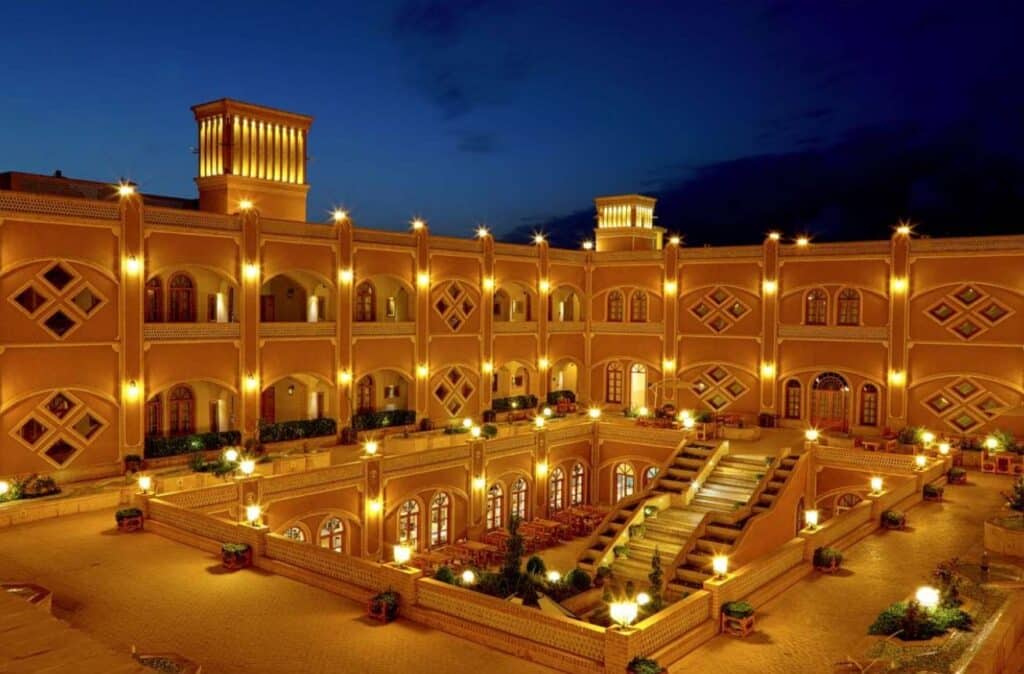
Amir Chakhmaq Square in Yazd is one of the most important historical squares in Iran, located in the city of Yazd. The square and its surrounding areas, as a complex, were constructed by Amir Chakhmaq and his wife Fatemeh Khatun, shaping a significant part of Yazd’s historical identity. This identity was forged through the efforts and collaboration of these two individuals. The prominent involvement of Fatemeh Khatun in the development and improvement of this structure is a fascinating aspect, rarely seen in other historical buildings.
The Amir Chakhmaq Square complex in Yazd consists of various sections including a Tekyeh (a place for religious gatherings), a market, a mosque, a water reservoir, and a mausoleum. In this article, I will discuss the beauties of Amir Chakhmaq Square, the historical significance of this structure, and details about its different parts. Finally, I invite you to spend a few moments beside its beautiful, fountain-filled pool, reflecting on the vivid and illustrious past of this stunning structure.
Contents
Where is Amir Chakhmaq Square?
Address of Amir Chakhmaq Square: Yazd, Imam Khomeini Street, Amir Chakhmaq Square.
Location of Amir Chakhmaq Square on Google Maps
How to Reach Amir Chakhmaq Square?
Visiting the Amir Chakhmaq Square complex is possible via personal car, taxi, and bus. If you are using a personal car, you can use the location of this place on Google Maps for directions.
Accessing Amir Chakhmaq Square via Public Transport
Reaching Amir Chakhmaq Square by Bus
If you opt to take the bus, you should board buses running on the routes from ‘Quran Gate Terminal’ to ‘Martyrs of Mehrab Terminal’ or from ‘Ba’th Square’ to ‘Railway’. Get off at ‘Chahar Rah-e Shahda’ station. From here, it’s just a short walk to Amir Chakhmaq Square.
Amir Chakhmaq Square, Yazd: A Sight to Behold
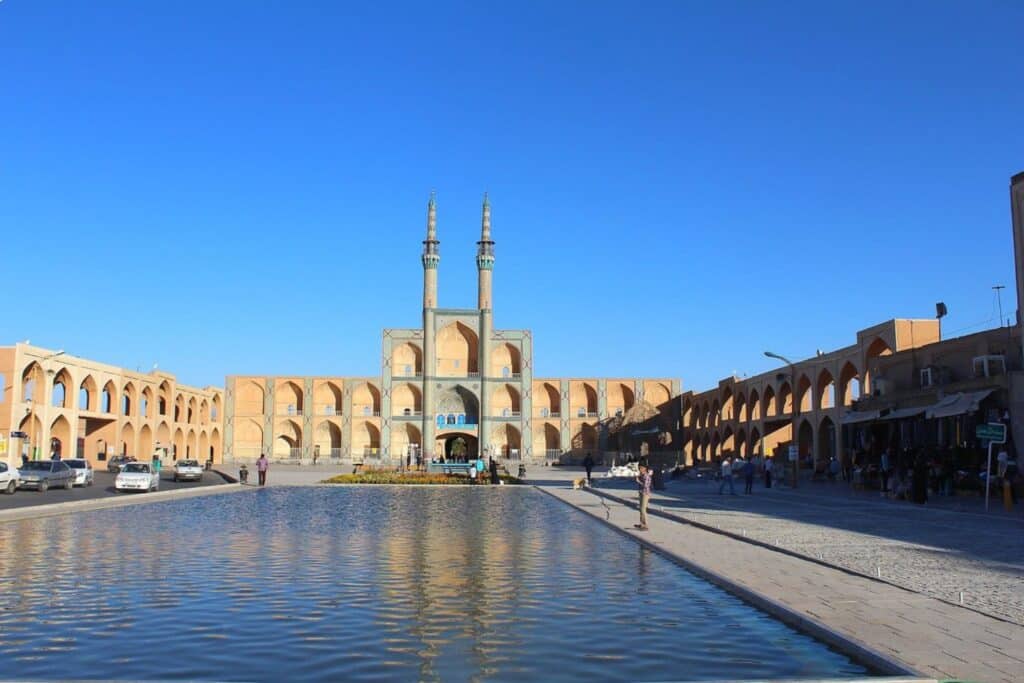
The Charm of Amir Chakhmaq Square in Yazd
Amir Chakhmaq Square in Yazd is one of the city’s most captivating tourist attractions, revered by the locals. Known among the people of Yazd as ‘Mir Chakhmaq’ or ‘Mir Chamag’, the square comprises a market, Tekyeh, mosque, two water reservoirs, and a mausoleum, highlighted by a large pond with attractive sculptures.
The Shaban Caravanserai lies on the northern side of the square, while the public bath and Baftiha Caravanserai are located to the west of the Tekyeh. The Amir Chakhmaq Square complex is a treasured historical site, officially listed in Iran’s national heritage registry.
The Historical Significance of Amir Chakhmaq Square
The Square’s Unique Role in Yazd’s History
Amir Chakhmaq Square holds a special place in the hearts of Yazd’s residents, symbolizing the city’s historical narrative. It’s known as ‘The Square of Yazdi Epics.’ The square has long been a gathering place for the people of Yazd during various events such as marches, demonstrations, and religious ceremonies. One of the most significant annual ceremonies held here is the ‘Palm Procession’ during Muharram, which attracts numerous tourists each year.
The History of Amir Chakhmaq Square
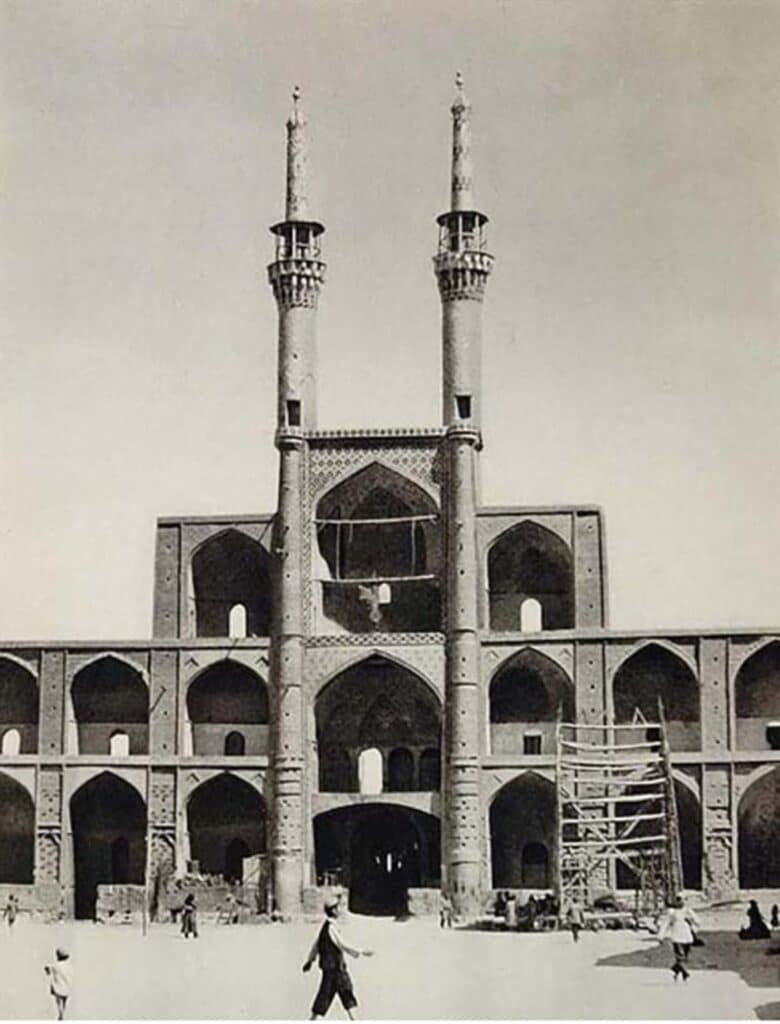
Tracing the Origins of the Square
The history of the Amir Chakhmaq Square complex dates back to the Timurid era in the 9th century AH. The square was constructed by the then ruler of Yazd, Amir Jalal al-Din Chakhmaq, and his wife Fatemeh Khatun. The purpose behind its construction was to further develop and beautify the city of Yazd. Initially, the Jameh Mosque of Now was built outside Yazd, in a place called Deh or Dehuk-e Sofla, which later became the center of Yazd. Following the mosque’s construction, other parts such as the public bath, caravanserai, Tekyeh, water reservoirs, etc., were added, completing the Amir Chakhmaq complex.
During the Safavid and Qajar periods, the square underwent various modifications. Shah Abbas renovated the square, and during the 13th century AH, the square and its market entrance were converted into a Hosseinieh (a congregation hall for Shia commemoration ceremonies). In the Qajar era, Haji Hossein Attar renovated the Jameh Mosque and added new parts to its prayer hall.
The early Pahlavi era saw Amir Chakhmaq Square being used as a burial site, a practice later halted by the Pahlavi government. They restored the square to its original bustling state by removing the graves.
Amir Chakhmaq Square underwent significant changes during Reza Shah’s reign. These changes were partly due to road construction in Yazd, which led to the demolition of some square walls. The square was redefined as smaller, integrating the mosque with the square in front of the Hosseinieh. Today, only the southeast wall of the Amir Chakhmaq complex remains, which constitutes the main body of the Tekyeh.
Who Was Amir Chakhmaq?
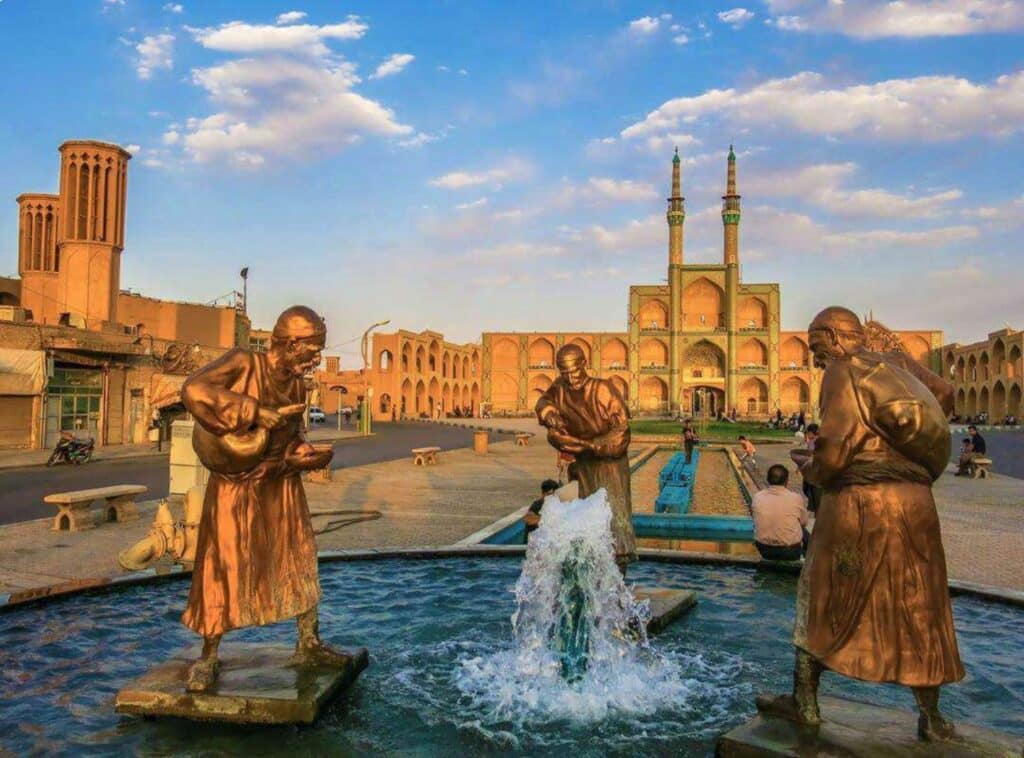
The Legacy of Amir Jalal al-Din Chakhmaq
Amir Jalal al-Din Chakhmaq Shami (Amir Chakhmaq) was a prominent commander under Shahrukh Timurid, who appointed him as the governor of Yazd in 836 AH. Inspired by Shahrukh’s governance style and with the support of his wife Fatemeh Khatun, Amir Chakhmaq dedicated much of his time to developing Yazd. His notable achievements include constructing a bathhouse opposite the Jameh Mosque of Yazd, building a brick pulpit in the mosque, completing the tile work on its columns, reviving the water supply of the Dehuk neighborhood, and restoring the Laristan Garden. However, his most significant contribution was the construction of the New Jameh Mosque, two water reservoirs, and a Tekyeh, now collectively known as the Amir Chakhmaq Square complex in Yazd.
Attractions of Amir Chakhmaq Square
Discovering the Wonders of Amir Chakhmaq Square in Yazd
Amir Chakhmaq Square in Yazd is not just a square; it’s a historical complex with each part boasting its own unique beauty and history. Let’s delve into the different sections of this amazing complex.
1. Haji Ghanbar Bazaar
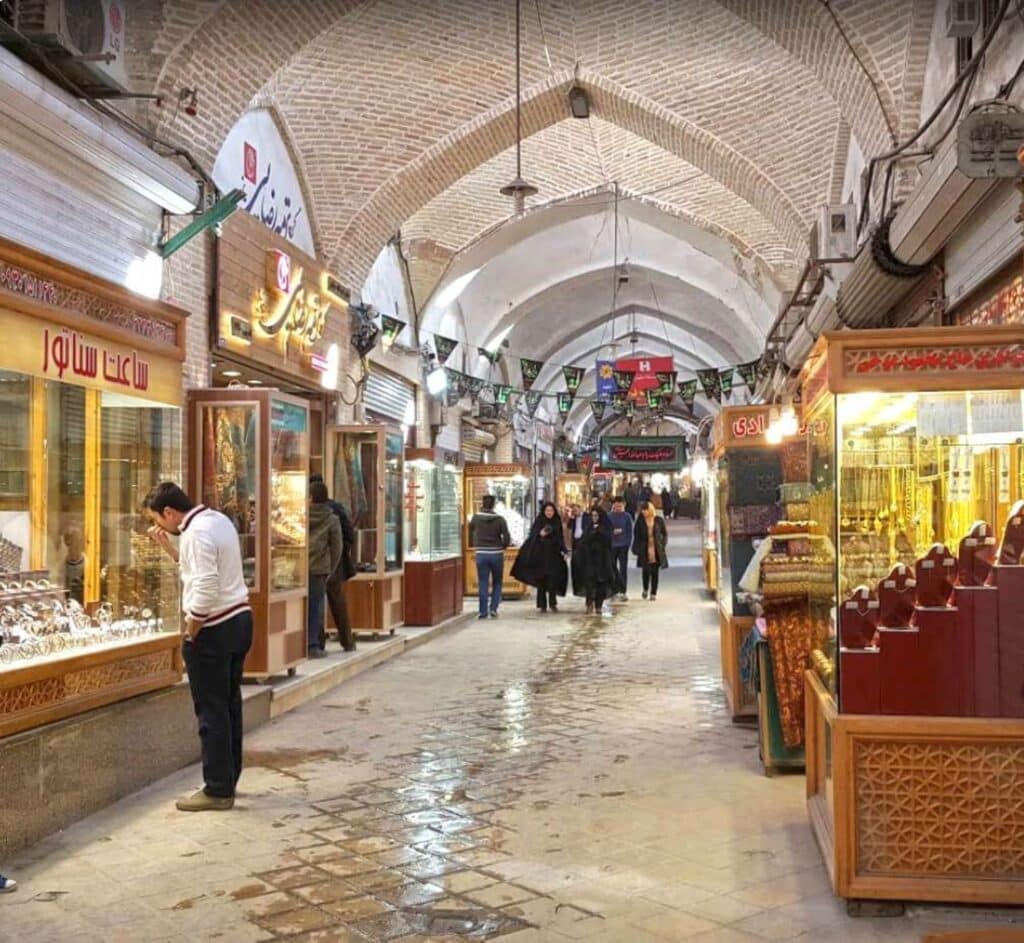
The old bazaar of Yazd is a significant historical site, divided into two during the Pahlavi-era urban developments. The northern part, known as Qeysarieh, remains more vibrant. The bazaar offers a variety of goods, including textiles, traditional Yazdi sweets, gold, carpets, and more.
Haji Ghanbar Bazaar, the oldest section of Yazd’s covered market, was named after Nizam al-Din Haji Ghanbar Jahanshahi, the governor of Yazd in the 9th century AH. Its 500-year-old architecture and exquisite tilework make it a must-visit attraction in the Amir Chakhmaq complex.
Location of Haji Ghanbar Bazaar on Google Maps.
2. Tekyeh Amir Chakhmaq
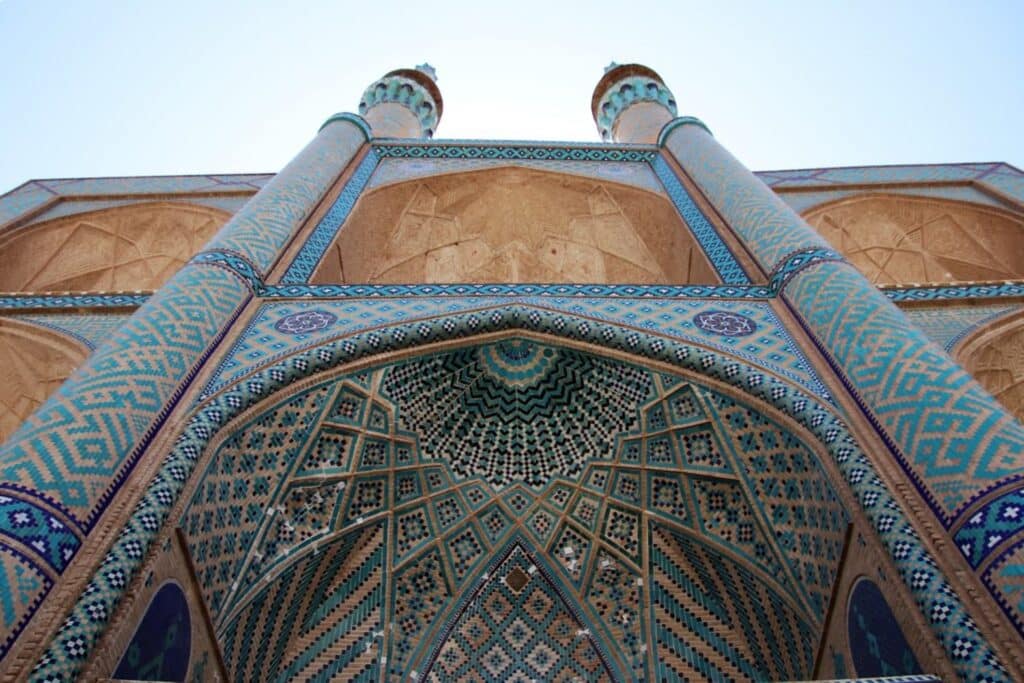
Tekyeh Amir Chakhmaq, located on the east side of the square and listed as a national heritage site in 1330, serves as a venue for religious ceremonies. During the 13th century and the Qajar era, the market’s entrance underwent changes, adding two minarets and the Tekyeh.
During the Pahlavi period, some market walls were demolished due to urban development, leaving only the main façade of Tekyeh Amir Chakhmaq. This three-story façade features brick stalls stacked in a terraced manner.
The middle section, known as Shah Neshin, is taller with eye-catching decorations and tilework. It served as a viewing spot for dignitaries during ceremonies. The side stalls were designated for women and ordinary people.
Tekyeh Amir Chakhmaq’s minarets tower above the Shah Neshin, calling people to prayer daily. An ancient inscription dating back to 1221 AH (180 years old) adds to its historical significance.
Tekyeh Amir Chakhmaq is the entrance to Haji Ghanbar Bazaar and is adjacent to the Jameh Mosque, with one of its stalls providing access to the complex’s water reservoir.
Location of Tekyeh Amir Chakhmaq on Google Maps.
3. Amir Chakhmaq Mosque
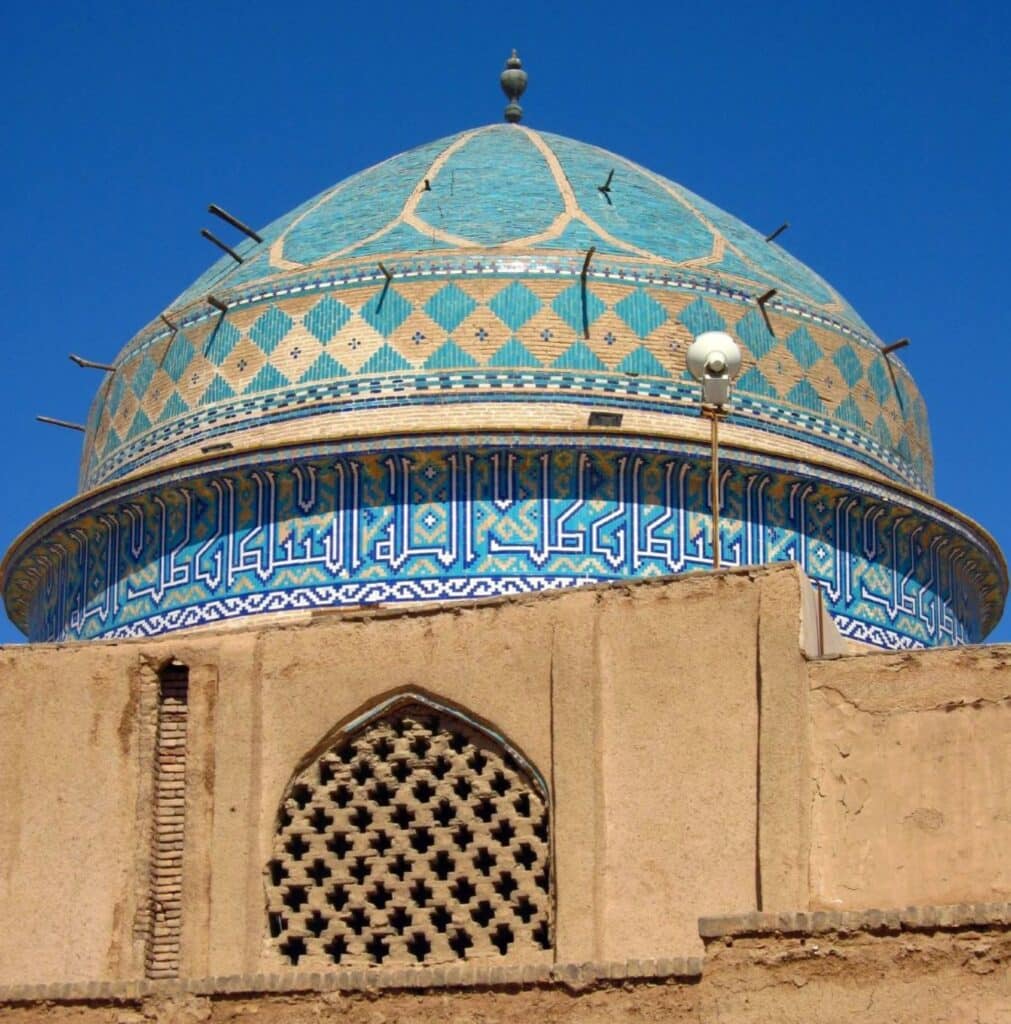
Also known as Jameh Mosque of Now or Dehuk Mosque, Amir Chakhmaq Mosque is one of the oldest structures in the Amir Chakhmaq complex. Commissioned by Amir Chakhmaq and his wife Fatemeh Khatun in 841 AH, it initially stood outside Yazd in Dehuk but became part of the urban fabric as the city expanded.
Listed as a national heritage site in 1341, Amir Chakhmaq Mosque is the second most important mosque in Yazd after the Jameh Mosque. Its stunning architecture is a marvel, with a beautiful green dome inscribed with Kufic script, capturing the attention of tourists from afar.
Exploring Yazd: Unveiling the City’s Charm, Brick by Brick
Yazd Attractions: Discovering the City’s Wonders
Amir Chakhmaq Mosque stands out for several reasons:
- Multiple Entrances: The mosque has various entrances, allowing access from different neighborhoods. One entrance leads from a nearby alley, and another opens from the courtyard of Seti Fatemeh’s mausoleum.
- Distinctive Shabestans: The mosque boasts two Shabestans – one for summer and one for winter. The summer Shabestan, with its architectural design and windcatchers, provides a cool space during hot months. The winter Shabestan, situated on both sides of the entrance corridor, relies on sunlight reflecting off marble stones for warmth and light.
- Exquisite Tilework: The mosque’s tilework, especially in the Mihrab and various sections, features captivating colors and designs.
It’s interesting to note that Amir Chakhmaq Mosque does not have minarets. The reason is unclear, but two theories exist. One suggests that mosques built by women historically lacked minarets. The other relates to its significance for both Sunni and Shia Muslims, as Sunni mosques typically have one minaret and Shia mosques two. The lack of minarets may symbolize unity and harmony between these groups, focusing on prayer rather than architectural distinctions. The mosque also features inscriptions in Thuluth and Kufic script, adding to its appeal.
Location of Amir Chakhmaq Mosque on Google Maps.
4. Nakhl of Amir Chakhmaq
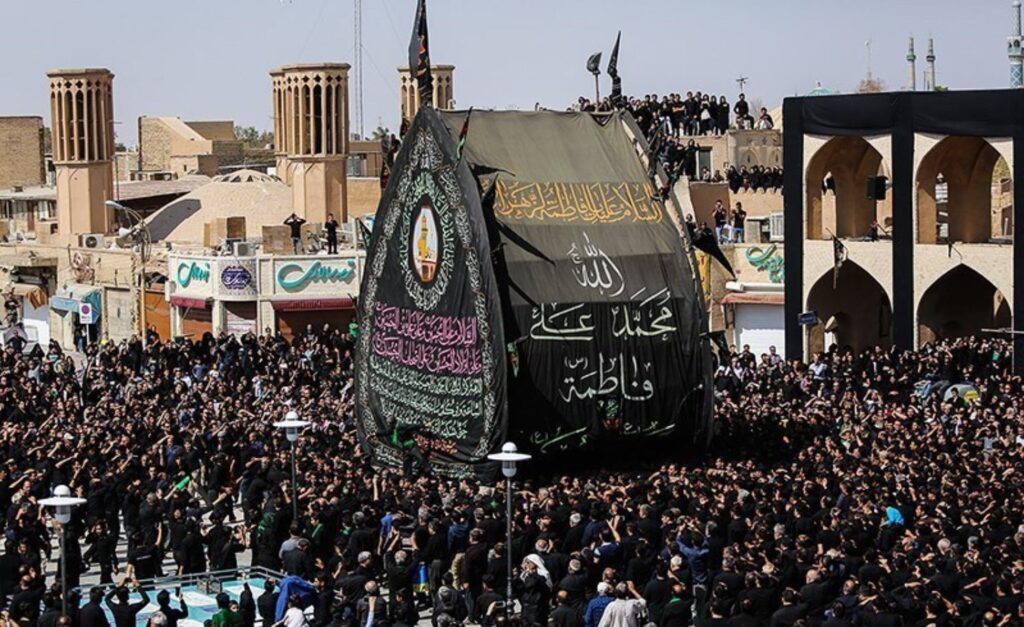
You might have heard of “Nakhl-gardani,” a symbolic ceremony performed during Muharram mourning in cities like Yazd, Estahban, Kashan, and Shahroud. Yazd’s ceremony is particularly renowned worldwide.
Amir Chakhmaq’s Nakhl is a massive wooden coffin-like structure, adorned with black and green cloths and carried by mourners. Decorative elements like mirrors and daggers are attached, each symbolizing aspects of the Ashura events.
Karakal Desert in Yazd: A Canvas of Nature in Browns Reading Suggestion: “Karakal Desert in Yazd: A Natural Painting in Brown Tones”
Amir Chakhmaq’s Nakhl, known as Nakhl-e Heydari, is one of Iran’s oldest, resembling a tall cypress tree, a symbol of freedom. Standing nearly 8.5 meters tall, it’s located east of Amir Chakhmaq Square.
Dating back 450 years to the Safavid era, the Nakhl has been a part of Amir Chakhmaq Square since 1229. In 1396, after 70 years, it was once again set in motion by mourners. The Nakhl is also preserved in the same area throughout the year.
Location of Nakhl of Amir Chakhmaq on Google Maps.
5. The Mausoleum of Seti Fatemeh
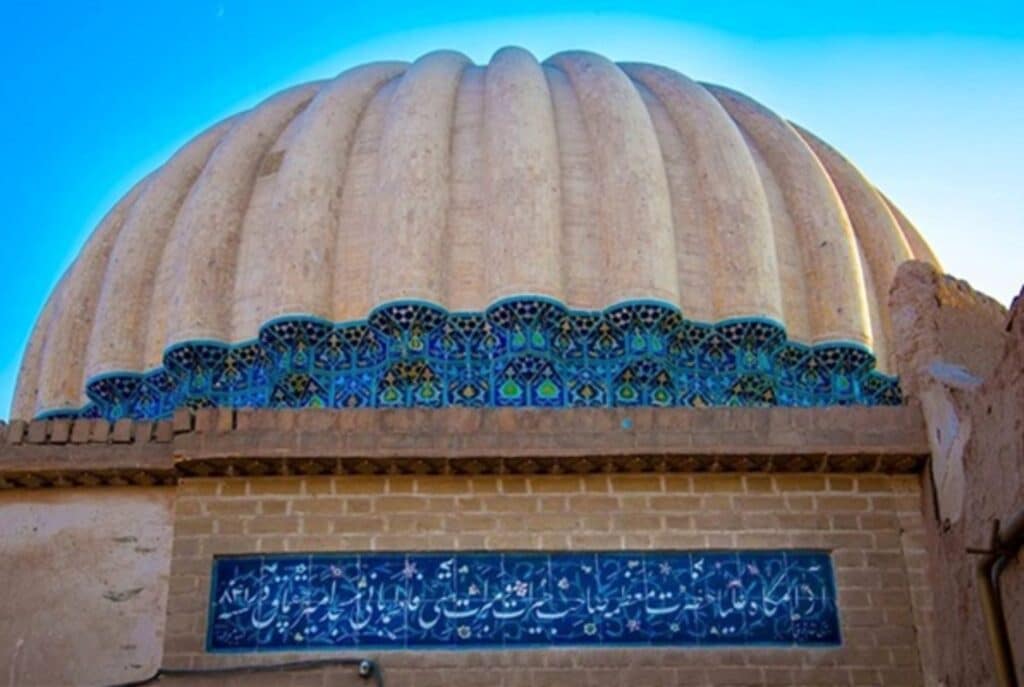
The Mausoleum of Seti Fatemeh, located north of Amir Chakhmaq Square, is a distinctive historical site in Yazd. Unlike many other tombs, this one is dedicated to a woman – Seti Fatemeh or Bibi Fatemeh Khatun, the wife of Amir Jalal al-Din Chakhmaq, a learned and powerful woman of the 9th century AH.
The term “Seti” is derived from the Sanskrit word “Sat,” which over time came to mean a woman of high status. Seti Fatemeh dedicated her life, alongside her husband, to the development and construction of valuable structures like the Amir Chakhmaq complex.
The Mausoleum’s Intricate Design
After her passing, Seti Fatemeh was buried in a structure she had commissioned near the Amir Chakhmaq Mosque. This beautiful mausoleum, characterized by feminine delicacy, exhibits the identity of this influential lady. The entrance, a double wooden door, leads through a small corridor into the dome, where her two-story marble tomb is located. It’s adorned with cypress tree carvings, a symbol of resurrection and life after death.
The mud-brick dome of Seti Fatemeh’s Mausoleum is the only “Khavarai” (melon-shaped) dome in Iran, reflecting the unique Timurid-era architecture. A similar dome can be found in Herat, Afghanistan, belonging to Goharshad Begum.
Historical Significance
As described in “Jame Mofidi,” a book on Yazd’s history and geography, “Near the marketplace of Mir Chakhmaq area, she built a dome for her burial place, adorned with colorful tiles. She is buried there. She also endowed a mill for her mausoleum, generating 800 man (a unit of weight) of wheat flour annually, of which one-tenth is allocated for the mausoleum’s upkeep.”
Unfortunately, until 1399, Seti Fatemeh’s Mausoleum was obscured by surrounding buildings. In 1399, negotiations with the Yazd Cultural Heritage Organization led to the purchase and demolition of these structures, revealing the dome and restoring its former prominence.
Location of Seti Fatemeh’s Mausoleum on Google Maps.
6. The Water Reservoirs of Amir Chakhmaq Square
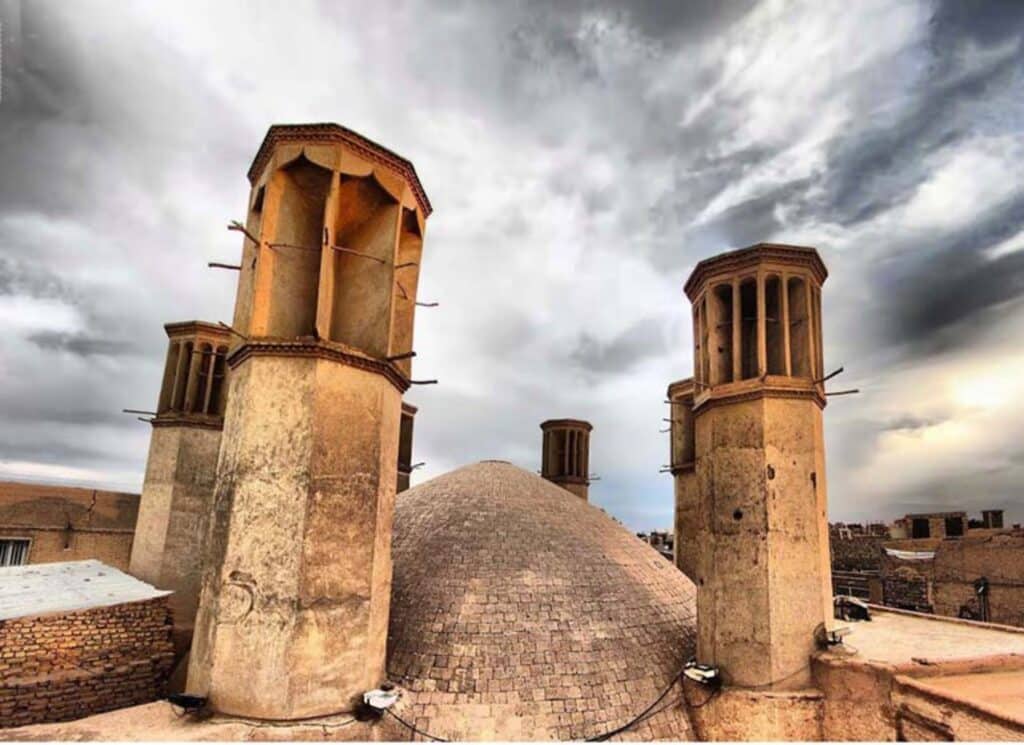
Amir Chakhmaq Square is famous for its ancient water reservoirs. A traditional underground reservoir, or “Aab Anbar,” is constructed in water-scarce, desert regions to store rainwater or water from seasonal streams.
In the past, the square boasted three major reservoirs: the Square’s Water Reservoir, Seti Fatemeh’s Water Reservoir, and the Amir Chakhmaq Tekyeh Water Reservoir. Only the latter two remain, having been in use until about 40 years ago. With the introduction of piped water in Yazd, these reservoirs lost their primary function and are now preserved as historical sites listed as national heritage.
Seti Fatemeh’s Water Reservoir
Constructed by Seti Fatemeh in Sheikh Assadollah alley on the northern side of Amir Chakhmaq Square, this reservoir is known for its large storage tank. Its egg-shaped dome, brick entrance, and five tall octagonal windcatchers make it an attractive site for tourists.
Saheb al-Zaman Zurkhaneh
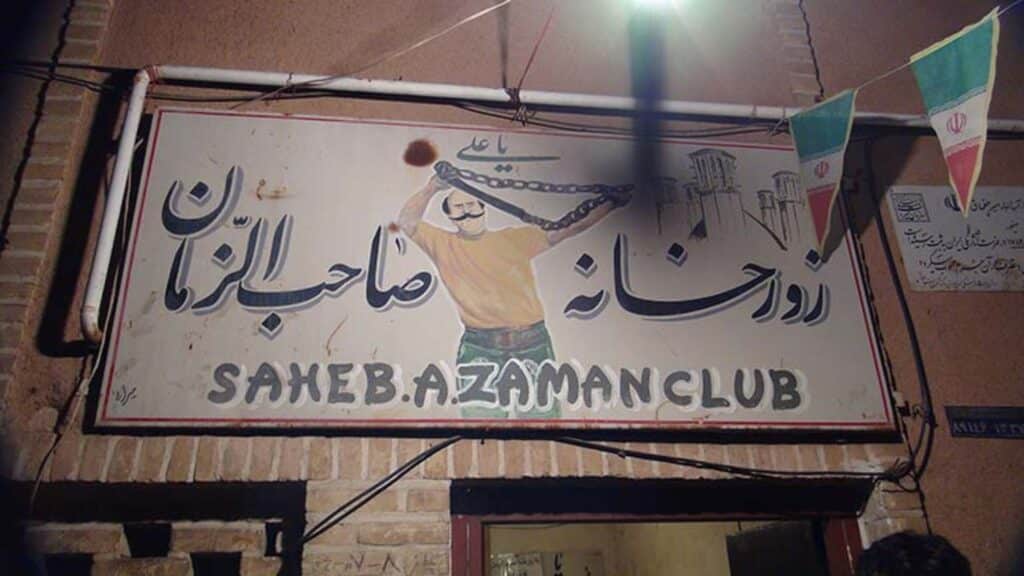
The unused Seti Fatemeh’s Water Reservoir was converted into the Saheb al-Zaman Zurkhaneh in 1380 by Pahlevan Ali Darahmi. It’s now the largest traditional gymnasium in Yazd. Tourists can enjoy 40-minute sessions here, witnessing ancient athletic performances.
